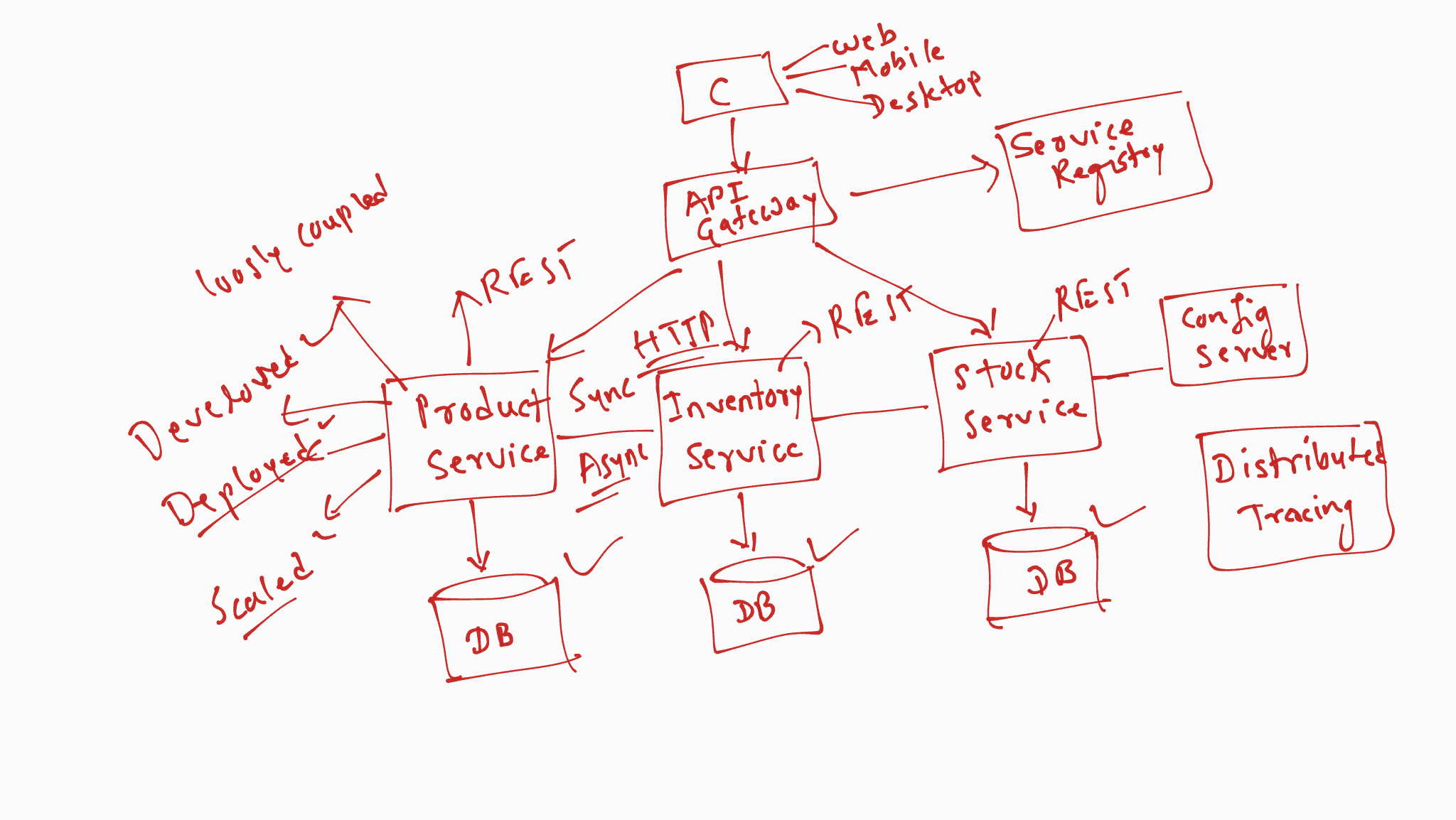The Shift from Monoliths to Microservices
In the past, most applications were built as monolithic architectures — single, large codebases where all components were tightly coupled. While this worked for small applications, it became problematic as applications grew in complexity. Enter microservices architecture, a game-changer in modern software development.
I am a bestseller Udemy Instructor. Check out my top 10 Udemy courses with discounts: My Udemy Courses — Ramesh Fadatare.
Check out my bestseller Udemy course: [NEW] Building Microservices with Spring Boot & Spring Cloud. // best on Udemy
Microservices break down an application into independent, loosely coupled services that communicate via APIs. This approach has transformed how businesses build scalable, resilient, and efficient applications.
For example, consider this microservice architecture for a simple shopping cart application. It has different services like product service, inventory service, and stock service, and these are the independent and loosely coupled services in the microservices projects.But why are microservices the future of software architecture? Let’s explore.
1. Scalability and Performance
Microservices Enable Horizontal Scaling
Unlike monoliths, where scaling means adding more resources to a single application (vertical scaling), microservices allow for horizontal scaling — scaling only the components that need more resources.
✅ Example: In an e-commerce application, the Order Service may receive high traffic during sales events. Instead of scaling the entire application, only the Order Service can be scaled independently.
✅ Benefit: Optimized resource utilization and cost savings.
2. Faster Development and Deployment
Agile Development with Small, Independent Teams
Microservices allow teams to work on different services independently, enabling faster development cycles.
✅ Example: The Product Team can update the Catalog Service while the Payments Team deploys improvements to the Payment Gateway without conflicts.
✅ Benefit: Faster feature releases and quicker response to market demands.
3. Improved Fault Isolation and Resilience
Service Failures Are Contained
In monolithic applications, a single failure can bring down the entire system. In microservices, failures are isolated, ensuring the rest of the system remains operational.
✅ Example: If the Notification Service fails, the Checkout Service can continue processing orders.
✅ Benefit: Increased uptime and better user experience.
4. Technology Diversity and Flexibility
Use the Right Tool for the Right Job
Microservices enable teams to choose different programming languages, databases, and frameworks based on each service’s needs.
✅ Example:
- User Service may use Node.js + MongoDB for high-speed processing.
- Billing Service may use Java + PostgreSQL for financial transactions.
✅ Benefit: Optimized performance and better technology adoption.
5. Enhanced Security and Compliance
Granular Security Controls
Microservices architecture enables better security through API gateways, authentication mechanisms, and service isolation.
✅ Example:
- OAuth2 and JWT can secure authentication.
- Role-Based Access Control (RBAC) ensures limited access to sensitive services.
✅ Benefit: Stronger security policies and regulatory compliance.
6. Cost Efficiency and Cloud-Native Readiness
Optimized Resource Utilization in the Cloud
Microservices are cloud-native, meaning they can leverage containerization, serverless computing, and automated scaling.
✅ Example:
- AWS Lambda can host stateless microservices with auto-scaling.
- Kubernetes helps orchestrate microservices efficiently.
✅ Benefit: Reduced operational costs and improved efficiency.
7. Event-Driven and Real-Time Processing
Asynchronous Communication with Event Streaming
Microservices can communicate asynchronously via message brokers like Kafka and RabbitMQ, enabling real-time processing.
✅ Example:
- Order Service publishes an event when an order is placed.
- Inventory Service listens to the event and updates stock levels instantly.
✅ Benefit: Better responsiveness and reduced latency.
8. Microservices and DevOps Synergy
Automated CI/CD Pipelines
Microservices work well with DevOps practices, allowing for continuous integration, deployment, and monitoring.
✅ Example:
- Automated unit testing for each service.
- Rolling deployments for zero downtime updates.
✅ Benefit: Faster, more reliable software delivery.
9. Global Adoption and Industry Use Cases
Major Companies Using Microservices
Leading companies have migrated from monoliths to microservices to scale better and enhance agility.
✅ Netflix: Uses microservices for streaming services and recommendation engines.
✅ Amazon: Handles millions of transactions with microservices.
✅ Uber: Uses microservices for ride booking, pricing, and location tracking.
✅ Benefit: Proven success in high-scale applications.
10. Best Practices for Microservices Implementation
How to Successfully Adopt Microservices
🔹 API Gateway: Manage authentication, routing, and rate limiting.
🔹 Service Discovery: Use tools like Eureka or Consul for automatic service registration.
🔹 Monitoring & Logging: Implement OpenTelemetry for observability.
🔹 Circuit Breakers: Prevent cascading failures with Resilience4j.
🔹 Data Management: Adopt database-per-service or event-driven patterns.
✅ Following best practices ensures smooth microservices adoption.
Conclusion: The Future is Microservices
As applications grow in complexity, microservices provide a scalable, resilient, and agile approach to software development. With cloud computing, DevOps, and event-driven architectures gaining traction, microservices are here to stay.
🚀 Ready to embrace the future? Start exploring microservices today! 🚀


Comments
Post a Comment
Leave Comment